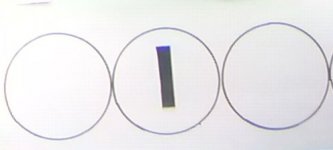Hello Brock,
Apparently, they have not carried out systematic studies about the globe effect, just a couple of rather informal gatherings which took place long time ago when Herr Dobler was still working with Swarovski. He has informed me that he doesn't have any data.
My 30% guesstimate is not fully waterproof either, and based on some assumptions. Look at the lowermost figure in
http://www.holgermerlitz.de/globe/test_distortion.html
This histogram summarizes the result of the checker board test. Those observers who have chosen 'A' are likely to have a very low amount of distortion of their visual system. Those who chose 'B' seem to have a minor barrel distortion, that is why they chose checker board 'B' with a slight pincushion distortion (which compensates for their barrel distortion) as their personal 'distortion-free' candidate, and so forth.
If a binocular that is free of distortion were panned, then the A-guys would be fine, while the B-guys would have to deal with a minor residual barrel distortion (the one of their own perception). Would that be sufficient to generate a globe-effect? Probably not, as my computer animations would indicate: The B-guys would still perceive an almost perfectly fine panning behavior. Somewhere between C and D, the residual barrel distortion would become obvious enough to enable the perception of the globe effect. I am quite sure that practically all individuals who have chosen D, E of F would clearly perceive the globe effect - look at Fig. 7 in
http://www.holgermerlitz.de/globe/distortion.html
These animations are generated while assuming a visual distortion of 0.6, corresponding to those guys who would choose 'D' in the checker board experiment. The lowermost row is calculated for distortion-free binoculars. Those guys would see quite a significant globe effect. Even with a distortion of 0.7 (checker board C), the globe effect is already quite pronounced, if the binocular is free of distortion (I had simulations for that, years ago, which are not shown here).
Now, the point is that the manufacturers like Swarovski are already moving away from the (almost) zero-distortion paradigm and are adding at least a little bit of pincushion. That reduces the fraction of people who could possibly perceive the globe effect. On the other hand, some of the real life binoculars do not at all have monotonous distortion curves, but curves which drop off near the edge. That does amplify the perception of the globe effect - actually, it is a local barrel distortion which is built into the optical formula. The combination of the pincushion distortion in the central regions of the field, then the inflection point, then the barrel distortion near the edges, leads to the mustache effect, which is not even included in my simulations and tests. Here I have simulated the particular example of the BPO
http://www.holgermerlitz.de/bpo7x30/bpo7x30.html
and how it does behave during panning.
In order to know how strong the globe effect is perceived, we need both distortion curves, the one of the individual observer and the one of the particular binocular he is using. Regarding the observers, we at least have some statistics, but regarding the instrument, the manufacturers should publish their distortion curves, something they refuse to do. That is why I have that disclaimer in
http://www.holgermerlitz.de/newk/newk.html
in which I note:
Another problem arises from the fact that the perception of the globe effect is not solely related to the k-factor, but also depending on the detailed shape of the distortion curve (from the center toward the edge), and these curves are not published by the manufacturers.
It is hard to judge the panning behavior of a binocular from the k-number alone, as long as there exist binoculars with mustache distortion of unknown intensity. Here, Henry's contributions are really useful, they allow us to get at least a couple of hints.
I finally had to give up any further studies on this subject, because no manufacturer was willing to supply the necessary data, i.e. the distortion curves of their binoculars.
Cheers,
Holger






